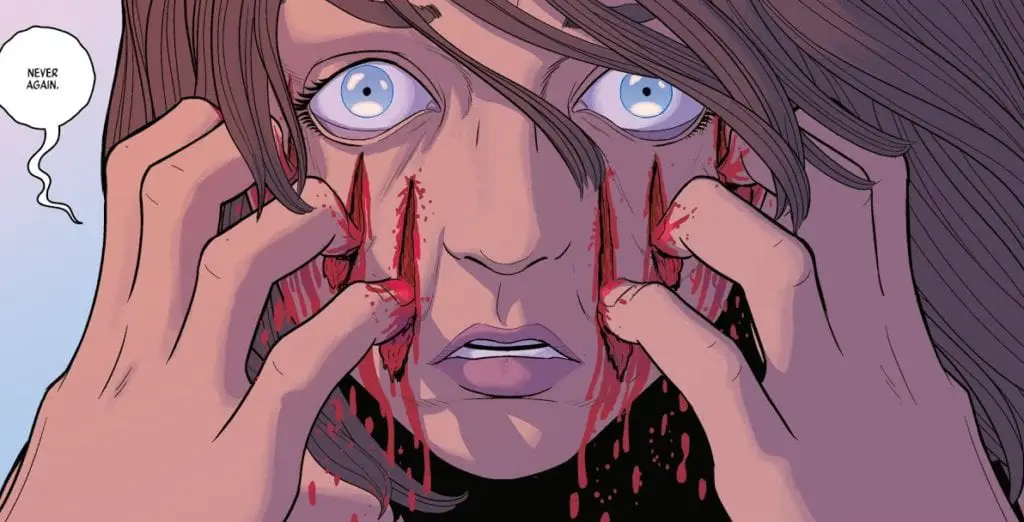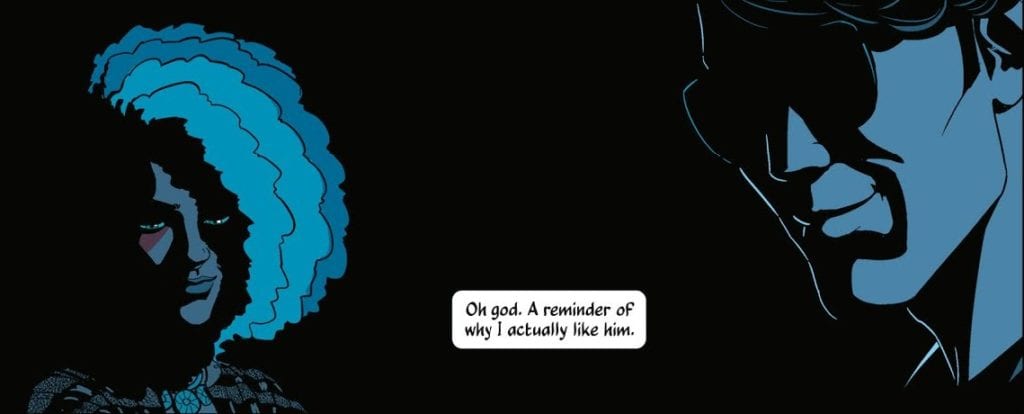Sometimes these things just write themselves. Upon reading this issue, my only question was if it’d be more suitable to call this “When the Wicked and the Divine Cry,” since there’s gonna be a lot of crying involved. In the end, my loyalty to Prince took priority, so we’re going with Crows, which is also suitable given the focus of this issue. If the Mothering Invention arc can stir one very legitimate complaint, it is how little focus there’s been on the Underworld Gods.
Not so this time. We’re reaching the final issues to this wickedly divine series. So if the Goths are getting a swan song, it had best be black as fuck. The doomed romance between Baphomet and The Morrigan comes to an end, featuring—of course—our tormented lead, Persephone…
Issue #37
“Never again”
… But first, a leap back in time, to the ancient infancy of the Recurrence for some further enlightenment. By now, we have sufficient pieces to make up a generous picture of the puzzle. As per the agreement between the first Ananke and the first Persephone, the former will always have two gods to inhabit: Minerva and herself. In order to protect her scheme to live eternally, this “dual Ananke” will always seek to destroy the one who could jeopardize her scheme: Persephone. As we’ve seen in the previous issue, this has resulted in violent and gooey outcomes for both. Should the Maiden and the Crone succeed, the young God will live on for ninety years until the next Recurrence, becoming the next Ananke, and so forth.
But it then brings up the question: What happens when Ananke or Minerva fail?
The answer lies in Egypt, 3127 BC. Having taken over the body of this Recurrence’s Minerva, Ananke attempts to do the four head ritual, one head short of the requirement. The smug confidence in her face turns to horror as she disintegrates, which goes to show that you should never aim lower than your goal; mediocrity drives us downward, people. In a similar fashion as last issue, we are treated to the passage of the years, one panel at a time. This will initially seem a lazy choice in design, having us readers look at nine panels of sheer black a page, one for each year. So we get ten pages of black panels. Ninety years til we continue the narrative in the shores of Crete, in the year 3037 BC.

Yet the subtle brilliance of this design is how it hearkens back to something Ananke said in a very early issue. The passage of time without Gods is without inspiration, comparatively dull if you focus only on the historical human experience sans the drama of the Recurrence. But there’s something else, a disturbing realization when looking at who appears to be Minerva, nude and staring blank out into the distance. Having scratched deep scars into her cheeks by despairing compulsion, she utters “Never again.”
The state of the young Goddess hints at a peculiar “newborn” state, which goes against the accustomed Ascension mechanic. If this is not a mortal become divine, then Ananke effectively remained “alive” in darkness for ninety years in one sitting. Never again, indeed.
Fast forward to the present, folks.
Things in the London of us mortals seem quite uneventful. That is, things are the same as usual. People ride the subway in the daily soul-crunching commute while entertaining idle talk. But the subject of chatter paints the course of events after Dionysus’ gig, which was taken over by asshole Woden. Cassandra earns the mythological character of her name by condemning Woden’s brainwashing of the masses, but nobody believes her. To add further insult, she is now behind bars. People ridicule the Norns, mourn Dionysus (while still mindlessly doing drug-themed victim blaming), take delight in their flawed memory of a “hell of a gig,” and life goes on. But in the neighboring Underground, affairs are not that simple.
Persephone meets up with Baphomet away from the vigilant gaze of his abusive girlfriend, The Morrigan, for some catching up. Keep in mind, he has missed a lot of the latest action, including all the death. As you can imagine, Dionysus’ demise is particularly hard on him. He remarks then that Marian will likely blame herself for choosing to keep away from mainstream Pantheon business. The current business absolutely demands the Underground to get involved, but first, there is a pressing question nobody has asked. Is Persephone okay?

Well, of course she’s not. In her inner monologue, she decides against telling Baph of her pregnancy, but has the candor to tell him she’s indeed not okay. However, there is some solace we find in the dark. Aside from Cass, Cameron here is the only one who gives a shit about Laura. And she has needed it for sure. So, it is nice to see a little friendship developing here despite the affair they had previously. In a visual sense, the game of shadows in the Underground accentuates the characters’ expressions. Things like concern and gratitude look paradoxically warm down here.
Meanwhile, Ananke-overwritten Minerva returns to her Headcave for some evil business. As a foil to the ominous mood and Minnie’s Anankish frown, we get to hear the heads talk a bit. Even in their current state, it’s nice to hear Luci being Luci, Inanna being Inanna. And we never did get to know Tara long, but… you know. Anyway, Minerva is texting Baphomet, still keeping up her charade to divert attention. At this point, it’s very likely that Woden is out to find the Heads, probably for his own shady agenda. As a preemptive measure or to the advance of her own plan, Minnie is going to sew their mouths shut. As you do.
Back in the Underground, Baph tells Persephone about Minerva’s text, when a wild Morrigan appears. Wild and very angry at Persephone being here. By the look of things, the Death Goddess is here to make good on her threat. It’s now that Baphomet realizes she meant for Sakhmet to kill Persephone. After knocking Laura out, Marian basically echoes every line in the abusive partner’s discourse, brutally demeaning Cameron while moving in to kill Laura. Baphomet urges her to think soberly. The final measure to bring this hermetic conflict to an end: he breaks up with his goth girlfriend.
“Hell hath no fury…” Congreve said. He probably did not visualize a threefold Goddess of War and Death with blades for hands. With a shriek, The Morrigan turns into her Badb Catha persona and turns her attention to Baphomet. And here is where it begins and where it ends. In this moment, I really want to personally praise Kieron, Jamie, and Matt for the dual narrative unfolding. And while you read those pages, I do hope you’re listening to something sad, like “Maybe Someday” by The Cure.
The fights between Gods have always looked spectacular in WicDiv, but never as emotional as this. In between the moments when Marian swarms Cameron with bloodthirsty birds, we see an alternating flashback to their past. Behind Baphomet’s flaming pole is the moment Cameron met Marian. The irremediably broken communication between the two is a tragic reprisal of the first time they exchanged words. Every strike is a shadow of the initial awkwardness. Marian’s spontaneous mutation into a bird of prey mirrors the mutation from affinity to interest. Their fight all over the subway station, their first dance together.
Cameron gets the upper hand. But the memory of that first night together makes him relent. He cannot finish her off. The Morrigan seizes the chance to turn the tables in a definite way. But the bloody victory tastes foul in her mouth. Laura wakes up to find the subway station in a foreboding state of destruction. There have been people injured, most likely also casualties. Finally, she arrives at the spot where Marian ended the argument, permanently. Shfiting from Badb Catha back to The Morrigan, Marian weeps while scratching bloody marks onto her face. Laura confronts her with the truth, that she just killed her boyfriend.
In response, Marian quotes a gentler self from issues past. “He’s not dead. He’s just sleeping.” She instantly turns into her third persona, Gentle Annie, the one we believed dead after Marian found out about Cameron and Laura’s affair. Also the one who imparted a painful truth upon Dionysus prior to his final gig, one that he tragically refused to heed.
You can’t save everyone.

But maybe you can save one. With a snap of her fingers, Marian—as Gentle Annie—brings Cameron back to life, at the cost of her own. This issue may just have brought the Underworld side of the Recurrence to its tragic end. After this, it’s time for Persephone and Baphomet to join the fray above, in whatever manner it manifests. A great issue, I’d say, perhaps my favorite so far, though it leaves such a bittersweet taste on the tongue.
This is what it sounds like when crows cry.
The Wicked + The Divine Issue 37 Credits
Writer: Kieron Gillen
Art / Cover: Jamie McKelvie, Matt Wilson

